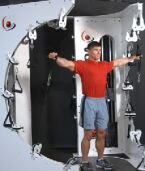Powerlifting

Dr. Horwitz deadlifts 545lbs. at the 1999 A.A.U. Maryland State
Powerlifing Championships.
His squat was 400lbs. and bench press was 310lbs. for a total of 1255lbs.

Dr. Horwitz deadlifts 580lbs. at the 2000 100% Raw World Championships.
His squat was 430lbs. and bench press was 315lbs for a total of 1325lbs.

|
For informative articles on training and great powerlifting equipment see: |
The sport of powerlifting requires the lifter to complete three lifts: the squat, bench press and deadlift. The lifter gets three attempts at each lift. The most weight lifted in each lift is recorded and the three amounts are added together to get a total. The lifter who lifts the most weight wins. There are many weight classes and age categories in which to compete.
Three judges watch each lift, two from the side and one in front. Each lift has certain specific requirements to be completed successfully.
In the squat, the lifter holds the bar on his shoulders and basically does a deep knee bend. The lifter must back out of the rack and wait for the front judge to say, "squat." The lifter must lower the weight until the top of the thigh is below parallel with the floor. The lifter must then stop once the weight has been lifted and wait for the judge to say, "rack" which means the lifter may place the weight back in the rack.
Squattin, by Dale Clark
Way down this road, in a gym far away,
A young man was once heard to say,
Ive repped high and Ive repped low,
No matter what I do my legs won't grow.
He tried leg extensions, leg curls, and leg presses, too.
Trying to cheat these sissy workouts hed do.
From the corner of the gym where the big men train,
Through a cloud of chalk and the midst of pain.
Where the big iron rides high and threatens lives,
Where the noise is made with big forty fives.
A deep voice bellowed as he wrapped his knees,
A very big man with legs like trees.
Laughing as he snatched another plate from the stack,
Chalking his hands and his monstrous back,
Said, Boy stop lying and dont say youve forgotten,
Trouble with you is you aint been squattin.
In the bench press, the lifter lies on his back and presses the weight from his chest to an arms straight out position. The lifter takes the bar off the rack, lowers the weight until it comes to a complete stop on the chest and waits for the judge to say, "press." The lifter then pushes the weight up and puts it back in the rack.
In the deadlift, the lifter lifts the weight from the floor to above his knees as in the picture. One hand grips with an underhand grip and the other with an overhand grip. The lifter lifts the weight, but must wait for the judge to say, "down." Only then can the lifter lower the weight to the floor.
In most powerlifting meets, the athletes are allowed to use a weightlifting belt, knee wraps, a very tight fitting wrestling type suit, wrist wraps and a very tight fitting shirt for bench pressing. What is now becoming popular is a division called "raw" which mean the lifter may wear a belt only, no other gear is allowed.
Bodybuilding

Dr. Horwitz won his height class in the 1986 A.A.U. Collegiate Mr. America
In only his second bodybuilding contest, Dr. Horwitz won his height class in the 1986 A.A.U. Collegiate Mr. America Bodybuilding Championships.
The sport of bodybuilding requires the athlete to pose to show his/her muscularity, definition and proportions. Most of the time, the athletes compete by weight class and age category. Sometimes, they compete by height class instead of weight class. A typical contest is divided into a morning round of mandatory poses and an evening round of an individual posing routine and pose off.
In the morning, the bodybuilders must perform mandatory poses, which are done from the front, sides and back. All the competitors in each weight class come out on stage and pose in front of the judges. The judges will pick out several top competitors in each class and make them pose against each other. Scores for each athlete are then tabulated.
In the evening, each competitor performs an individual posing routine to music, which lasts between 60 and 90 seconds. Posing for this long is quite exhausting. The top three or five in each class are asked to "pose off" against each other and a winner is proclaimed. Then, the winners of each weight class pose off and an overall winner is chosen.
Definitions of Weightlifting
There are several categories of people who exercise with weights. These categories are often referred to as: weight lifting, weightlifting, Weightlifting, weight training, bodybuilding, powerlifting, lifting, Olympic lifting, Olympic-style weightlifting, strength training and resistance training. Let's clarify the differences.
Weightlifting: Weightlifting, weight lifting and weightlifting all have a "generic" meaning which refers to the activity of lifting weights. To those who are well versed in the use of weights, the word weightlifting has a particular meaning. It refers to the Olympic sport of Weightlifting, which tests strength a power through two methods of lifting a barbell overhead - the Snatch and the Clean and Jerk. Weightlifting is the only Olympic sport involving weights, which is why it is sometimes referred to as Olympic lifting or as Olympic-style lifting, or Olympic-style weightlifting.
Weight Training: Weight training refers to any activity which involves the use of weights. The term weight training is commonly used in referring to people who lift weights but not for the purpose of competing in bodybuilding, powerlifting or weightlifting (although many people lift weights as a means for improving their performance in another sport). Many people who lift weights refer to themselves as "lifters" for short.
Resistance Training: Resistance training is an even broader term than weight training because resistance can be supplied by weights, machines, rubber strands and any number of other devices that resist the movement of the exerciser. It is nearly impossible to engage in any vigorous resistance training without getting stronger as a result. However, strength training is a means of training with resistance that is focused on improving strength, as compared with muscle size (although people who train for strength are often seeking increased muscle size as well).
Bodybuilding: Bodybuilding is a sport or activity in which the primary objective is to develop the size of the skeletal muscles. Bodybuilders focus on other areas as well, such as developing all of the muscles proportionally (symmetrically), minimizing body fat and increasing their strength. Because bodybuilders focus on muscular development, that is the main thing they achieve. Strength, for example, tends to take a back seat to size (though many bodybuilders are very strong).
Powerlifting: Powerlifting is a great sport that was conceived as a pure test of strength. And it tests strength about as well as Olympic-style Weightlifting. The sport that consists of three events: squat, bench press and deadlift. Powerlifters are very strong because they focus on developing that capacity exclusively. Overall, the strength of powerlifters very close to that of Olympic-style weightlifters. However, powerlifting is not an Olympic sport and it has multiple "federations" which govern it, so there can be multiple "world champions" each year (Olympic-style Weightlifting has only one international governing body and one world champion per weight class worldwide). Powerlifting is also not practiced as widely as weightlifting. For all these reasons, the level of competition tends not to be as high in powerlifting as it is in weightlifting, which is why competitive Weightlifters, as a group, have earned the right to call themselves the strongest athletes alive. More importantly, no other athletes approach the strength of weightlifters and powerlifters, as the men and women who compete in these sports are totally focused becoming the strongest athletes in the world. Moreover, they compete on measurable events which are standardized worldwide, so that performances can be reasonbly compared. You won't see these athletes flexing their muscles or lifting tree trunks on "pay-per-view", but they are quietly driving the levels of human performance to all time highs.
|
The Ultimate Nutritional Lie Detector Test LEARN MORE 
|
Kettlebell Rehab

Click Here
To See How Kettlebells will transform your body!
Vortex Rehab

Click Here
To See How This
Revolutionary Machine
Can Help You!
Partner / Support

Loans up to 3 months - fast cash advances for up to 90 days and up to $5,000!


















